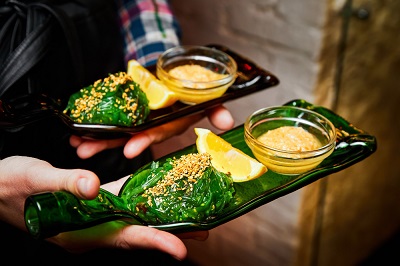 While they are not, technically, a vegetable, seaweeds are often called sea vegetables. They are an integral part of Japanese cooking.
While they are not, technically, a vegetable, seaweeds are often called sea vegetables. They are an integral part of Japanese cooking.
Cultures around the world, in fact, partake of various forms of sea vegetables. Practitioners of macrobiotics rely on seaweed as a staple food.
There are quite a few different types of these sea-dwelling, edible plants, all of which have great nutritional value. Here are some of the more common seaweeds, and the nutrients present in them:
- Arame – This dark sea vegetable has a large leaf which is shredded before drying and packaging. It contains calcium, iron, vitamin A, niacin (vitamin B12), and significant iodine.
- Kombu – Also high in iodine, kombu comes in strips and is often cooked with beans to increase their digestibility. It also contains calcium (though not as much as arame), iron, vitamins A and C, and niacin.
- Hijiki – This strong-flavored seaweed has the highest amount of calcium of all the common seaweeds. It does not contain any vitamin C, but it does have varying proportions of the same nutrients noted above.
- Wakame – This is popular in traditional Japanese miso soup. It is a kind of kelp, and is quite high in calcium and niacin.
- Nori – You might recognize this seaweed if you eat sushi. Toasted sheets of pressed nori are wrapped around sweet sushi rice and various fillings. This sea vegetable has the highest protein, vitamin A and niacin content of any seaweed.
- Dulse – Popular dried and eaten as a salty snack, this purplish seaweed is sometimes ground to a powder and used as a condiment. It is lower in calcium and iron than other seaweeds, and contains no vitamin A or niacin. It is, however, high in vitamin C, protein, and iodine. Dulse also has a healthy ratio of omega-3 and omega-6 fatty acids.
- Agar-agar – Tasteless and odorless, agar-agar is distinctive among the sea vegetables. It is used as a gelatin when making jello-like desserts. It is also used in ice cream and other dairy products to give them a cohesive, thick consistency. It has the lowest nutritional content of the sea vegetables listed here, except with regard to calcium. It has more of that mineral than nori.
The consumption of sea vegetables has, according to macrobiotic cook and author Wendy Esko, been proven to help reverse cardiovascular diseases, shrink tumors, and even eliminate the ill effects of radiation exposure.
Brown seaweeds such as arame contain a carbohydrate called fucoidan, which studies have shown has, among other properties, anti-tumor and anti-inflammatory action. And sea vegetables do contain soluble fiber, so the good effect on cardiovascular health is understandable.
Seaweeds can take some getting used to, but starting with small amounts of the milder varieties – such as arame and kombu – can help make the transition easier.





